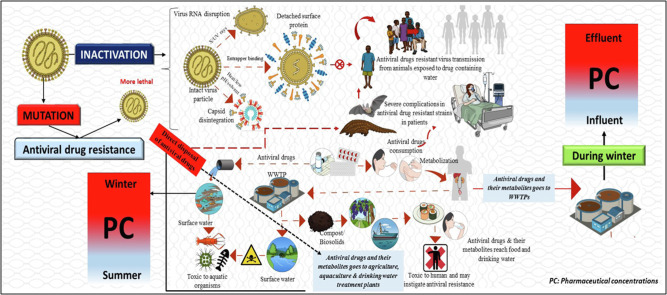- Record: found
- Abstract: found
- Article: not found
A Chronicle of SARS-CoV-2: Seasonality, Environmental Fate, Transport, Inactivation, and Antiviral Drug Resistance

Read this article at
Abstract
In this review, we present the environmental perspectives of the viruses and antiviral drugs related to SARS-CoV-2. The present review paper discusses occurrence, fate, transport, susceptibility, and inactivation mechanisms of viruses in the environment as well as environmental occurrence and fate of antiviral drugs, and prospects (prevalence and occurrence) of antiviral drug resistance (both antiviral drug resistant viruses and antiviral resistance in the human). During winter, the number of viral disease cases and environmental occurrence of antiviral drug surge due to various biotic and abiotic factors such as transmission pathways, human behaviour, susceptibility, and immunity as well as cold climatic conditions. Adsorption and persistence critically determine the fate and transport of viruses in the environment. Inactivation and disinfection of virus include UV, alcohol, chemical-base methods but the susceptibility of virus against these methods varies. Wastewater treatment plants (WWTPs) are major sources of antiviral drugs and their metabolites and transformation products. Ecotoxicity of antiviral drug residues against aquatic organisms have been reported, however more threatening is the development of antiviral resistance, both in humans and in wild animal reservoirs. In particular, emergence of antiviral drug-resistant viruses via exposure of wild animals to high loads of antiviral residues during the current pandemic needs further evaluation.
Graphical Abstract
HIGHLIGHTS
-
•
We analysed environmental perspectives of antiviral drugs and SARS-CoV-2.
-
•
Susceptibility and inactivation causes seasonality in the prevalence of SARS-CoV-2.
-
•
Surface-charge interactions govern environmental fate and transport of SARS-CoV-2.
-
•
Unprecedented use of antiviral drugs is hazardous to the environment.
-
•
Emergence of antiviral drug-resistant viruses needs further investigations.
Related collections
Most cited references150
- Record: found
- Abstract: found
- Article: found
Clinical Characteristics of 138 Hospitalized Patients With 2019 Novel Coronavirus–Infected Pneumonia in Wuhan, China
- Record: found
- Abstract: found
- Article: not found
Persistence of coronaviruses on inanimate surfaces and their inactivation with biocidal agents
- Record: found
- Abstract: found
- Article: not found


